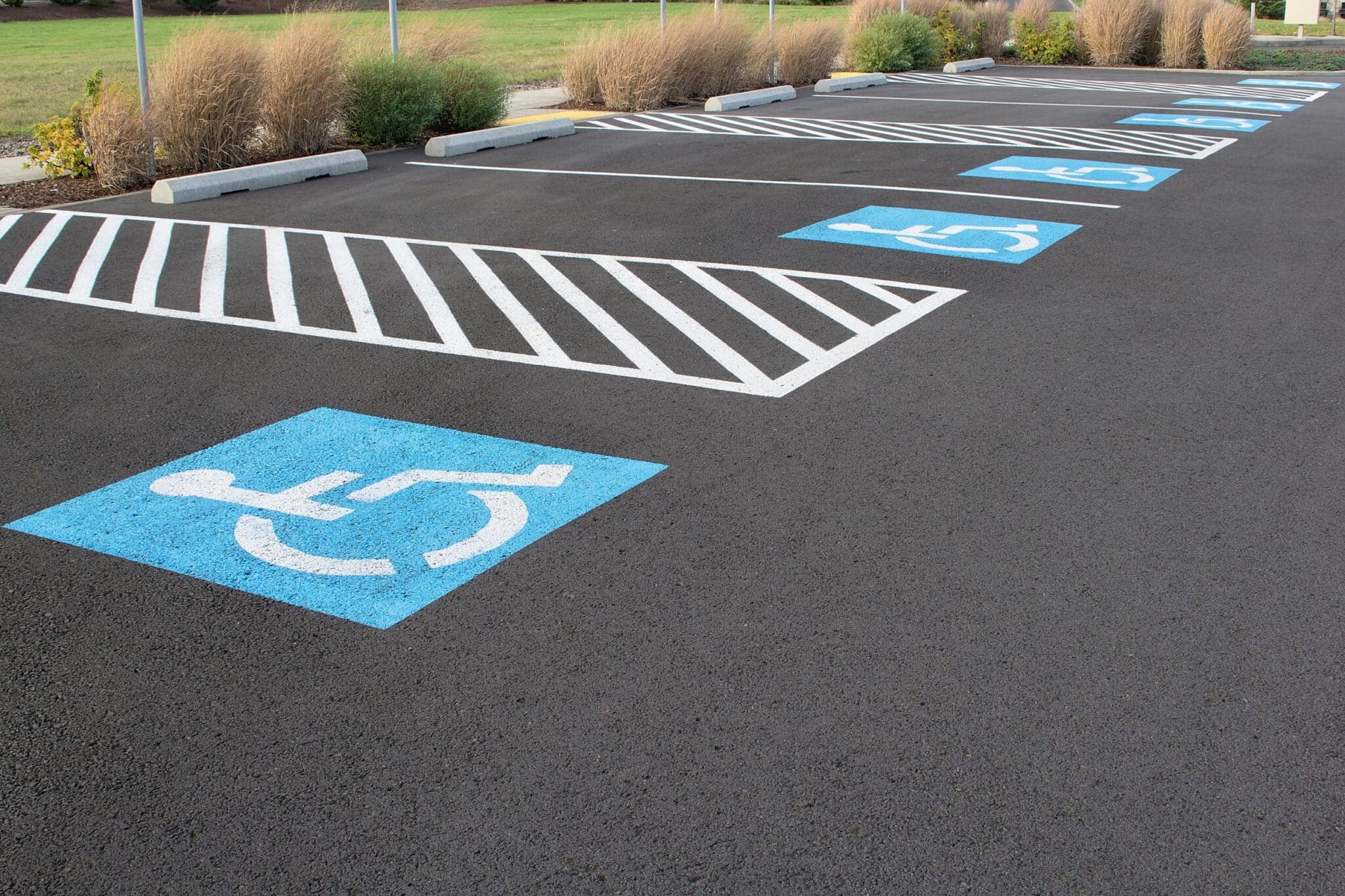If you are a business owner, it is important to be aware of the ADA (Americans with Disabilities Act) guidelines for parking lots. These regulations exist to ensure that people with disabilities have equal access to public spaces. In this article, we will cover everything you need to know about the ADA guidelines for parking lots, including what they require and how you can comply.
ADA Guidelines for Parking Lots
The ADA guidelines for parking lots are set forth in the ADA Standards for Accessible Design. These standards require that all newly constructed or altered parking facilities include accessible features and safety features for people with disabilities.
Handicap parking is important to provide for people with disabilities who have difficulty walking or who use mobility devices such as wheelchairs. Thus, ensuring your lot has handicap parking spaces is one of the most important things you can do to comply with the ADA guidelines.
Some of the most important requirements for handicap parking lots include:
- A minimum number of accessible parking spaces, based on the total number of parking spaces in the lot.
- Accessible routes from the parking spaces to sidewalks, buildings, and other destinations.
- Striping to indicate all accessible routes.
- Accessible parking space identification signs that meet specific size and contrast requirements.
- Wheelchair-accessible ramping.
- Van-accessible parking spaces that meet additional size and maneuvering requirements.
- Adequate lighting.
Complying with the ADA guidelines is a necessary task. These features are in place to ensure that everyone has equal access to public spaces. By taking the time to familiarize yourself with the standards and ensure your parking lot meets all the necessary requirements, you can avoid potential legal trouble down the road.
ADA Parking Stalls
To comply with the ADA guidelines for parking lots, you must provide a certain number of accessible spaces. This is based on the total number of parking spaces in your lot.
It’s one accessible space for every 25 conventional spaces. One of every six accessible parking spots must be van-accessible, in accordance with the 2010 ADA standards.
For example:
A parking lot with 100 parking spaces must have four accessible spaces. Of those four, one must be van accessible.
Medical Facilities
If your parking lot is associated with a healthcare facility, the ADA compliance guidelines are slightly different.
For outpatient facilities, 10% of all patient and visitor parking spaces must be accessible. Likewise, rehabilitation facilities with a focus on mobility-related health conditions and outpatient physical therapy facilities must have 20% accessibility of all patient and visitor parking. In addition, van-accessible spaces are one of every six, or fraction of six, designated patient and visitor parking spaces.
Location of Accessible Spaces
Accessible parking spaces must have the shortest possible route of travel to an accessible entrance. If a parking facility serves multiple buildings or entrances, accessible parking spaces must be spread out so people can park as closely as possible to as many entrances as they can.
If there are multiple parking lots for the same building, accessible parking spaces can be grouped together if the total number of accessible spaces meets the requirements.
The closest designated space to the main entrance should always be van-accessible, with priority given to those who need it most. If that’s not possible, then the next best option is a location that’s as close to the main entrance as possible.
Design
The dimensions of stalls and aisles for handicap parking must meet certain requirements:
- Accessible parking spaces are 8 feet wide
- Van-accessible spaces are 11 feet wide.
- Access aisles for either type of space are 5 feet wide.
- Alternate designs allow van-accessible spaces to be 8 feet wide if the adjacent access aisle is also 8 feet wide.
- You must mark the access aisle with hatch marks to discourage people from parking there. This is especially important if you are using an alternate design and the access aisle is the same size as the parking space.
- You must make sure that the surface of accessible spaces and access aisles are smooth, stable, and level in all directions. This will ensure that people with disabilities can use them safely, including those who need to load and unload wheeled mobility devices.
- You must make sure that the spaces for vans have enough clearance so that the wheelchair lift on the van can fit. This clearance should be at least 98 inches.
Pavement Painting Specifications
Specific pavement painting requirements must be met to comply with the ADA standards for parking lots. These include:
- All lines defining parking spaces, aisles, and curbs should be painted.
- The lines must be at least four inches wide.
- All handi-accessible parking spaces should be painted blue.
- The international symbol of accessibility should be painted in the center of each space.
- Van-accessible spaces should have an added sign that says “van-accessible” next to the wheelchair symbol.
This signage and painting must be done in a way that ensures it is visible, legible, and durable.
Accessible Routes
In addition to the designated handicap parking spaces, you must also have accessible routes leading from the parking lot to the building. These routes should be at least 36 inches wide and must not have any stairs or curbs.
The route should be well-lit and free of obstacles. If the route goes through a landscaped area, you must make sure that the landscaping does not block the path or create any tripping hazards.
Signs
You must have signs that designate handicap accessible parking spaces. These signs should be at least five feet above the ground. This helps ensure visibility both for motorists and law enforcement officials.
However, there are exceptions to this. Small parking lots with four or fewer spaces must have accessible spaces, but these do not need a sign. Anyone, regardless of disability, can use the accessible spot. Additionally, residential facilities that allocate parking spaces to specific dwelling units do not have to install signs at accessible parking locations.
How to Become an ADA Compliant Parking Lot
There are a few things you need to do in order to become an ADA compliant parking lot.
- First, ensure that your parking lot meets the minimum number of accessible spaces required. Remember, this number depends on the total number of spaces in your parking lot.
- Second, you need to make sure that the stalls and aisles meet the specific dimensions required by the ADA. Review the specifications carefully and measure if necessary.
- Third, you need to make sure that your pavement is painted according to the specifications laid out by the ADA. If you find that your parking lot striping and signage does not meet the requirements, you will need to have it redone.
- Finally, you need to make sure that there is an accessible route from the parking lot to the building. If you find that your current route does not meet the requirements, you will need to make some changes.
Making sure that your parking lot meets all ADA parking requirements is important not only for new facilities but for existing facilities as well.
New Facilities
If you are building a new parking lot, you need to make sure that it meets the ADA requirements from the start. This includes making sure that the right number of accessible spaces are included, that the dimensions of the stalls and aisles meet the ADA specifications, and that the pavement is properly painted and signed.
Existing Facilities
If you have an existing parking lot, you may need to make some changes in order to bring it up to ADA standards. This could involve adding additional accessible spaces, repainting the pavement, or creating a new accessible route.
However, there are some situations where an existing parking lot does not need to be modified. If your parking lot is grandfathered in or if it would pose an undue financial burden to make the changes, you may not have to do so.
Benefits of Having a Compliant Parking Lot
There are many benefits to having a parking lot that meets the ADA guidelines:
- First, it ensures that people with disabilities have equal access to your facility. This is important not only for compliance but also for ethical reasons.
- Second, it can help you avoid potential lawsuits. If someone files a complaint against your business because they were unable to access your parking lot, you could face a lawsuit.
- Third, it can help you avoid fines and penalties. If you are found to be in violation of the ADA, you could be subject to fines from the Department of Justice.
- Fourth, it can help increase your customer base. When people know that your business is accessible, they are more likely to visit.
Making sure that your parking lot and all parking space stalls are ADA compliant is important for a number of reasons. By taking the time to ensure that your parking lot meets the guidelines, you can avoid potential problems and ensure that everyone has equal access to your facility.
Become ADA Compliant Today
ADA Guidelines for parking lots are an important consideration when it comes to the safety and usability of parking lots. Here at Superior Asphalt, LC, we offer asphalt repair and maintenance, and parking lot striping services that can help you ensure your lot meets all ADA requirements. Contact us today to get started!




